Drilling Report
Advanced and emerging drillstring technologies overcome operational challenges
New materials and designs open the way forward for ultra-deep drilling.
R. Brett Chandler and Michael J. Jellison, Grant Prideco; Mike L. Payne, BP America and Jeff S. Shepard, GlobalSantaFe
Drilling ultra-deep wells places significant requirements on the drillstring. Lengthy drillstrings lead to high tensile loads, which lead to slip-crushing, hoisting issues and drill pipe collapse capacity concerns at the blowout preventer. BOP shear rams may also have difficulty cutting today’s high-strength, high toughness drill pipe. BHA connection failures pose greater risk and cost at ultra-deep well depths.
This article analyzes the many challenges of drillstring designs, specifically for ultra-deep drilling. It presents emerging drillstring technologies that are expected to increase depth capability for continued deep drilling advancement.
DEEP DRILLING TREND
Deep drilling trends in the US and throughout the world are increasing. Since 1995, the number of US wells drilled, greater than 15,000-ft TVD, has more than doubled, Fig. 1. The number of annual, active US rigs drilling greater than 15,000-ft TVD has nearly tripled, Fig. 2.1 The number of high-pressure, high-temperature (HPHT) completions in the US has nearly tripled since 2000.2 US gas production from “deep” formations is also expected to double from 7% in 1999 to 14% by 2010.3
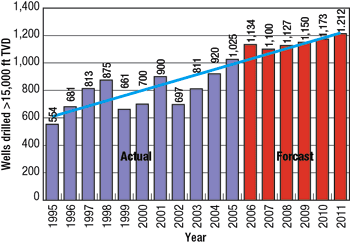 |
Fig. 1. Increasing trend of US wells drilled greater than a 15,000-ft TVD. Since 1995, the number of wells has more than doubled.1
|
|
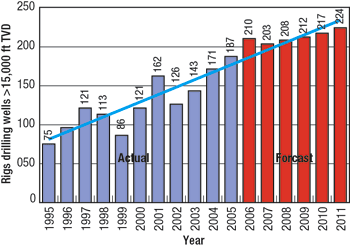 |
Fig. 2. Since 1995, the number of active US rigs working each year, drilling wells greater than a 15,000-ft TVD has nearly tripled.1
|
|
During late 2005, the Knotty Head well in Green Canyon Block 512 was drilled to a TD of 34,189 ft, the Gulf of Mexico’s deepest well ever drilled. The 14¾-in. hole section was drilled to 24,085 ft, and over 4 million ft, or about 757 mi of drill pipe, were tripped throughout the course of the well. The previous record well in the Gulf of Mexico was drilled earlier in the year to 32,727 ft, TD.4
Many rig contractors are presently upgrading or building new jackups, semisubmersibles and DP drillships capable of drilling to 35,000 ft. One rig contractor recently signed for the manufacture of a $650 million DP drillship capable of drilling in 12,000 ft of water to well depths of 40,000 ft.5 Wells to these depths will require substantial investment and technology advancement for Ultra-Deep Drilling (UDD).
EXTENDED REACH VS. ULTRA-DEEP DRILLING
Enabling technologies and innovative techniques have contributed greatly to the industry’s ability to reach significant well-departure distances. This is evidenced by extended reach projects around the world.
A key difference between Extended Reach Drilling (ERD) and UDD is the mechanical loading that occurs within the drillstring. ERD drillstring loading can be characterized as high torque and low tension, while UDD can be characterized as high tension and low to moderate torque. For purposes of definition, the authors define UDD as wells deeper than 25,000-ft TVD and reach/ TVD ratios less than 0.25. This well type requires drillers to focus on maximizing the drillstring’s tension carrying capacity, reducing tension loading within the string and outfitting the rig and its equipment to support higher tension loads. Unlike the torque reduction challenges overcome for ERD, these drillstring tension obstacles may prove more challenging. This is largely because the drillstring is comprised of steel drill pipe of a set density (0.283 lb/in3) and yield strength (135,000 psi). Since most challenging well types define the drill pipe size(s) based on the well’s hydraulic requirements and use S-135 steel drillstring, a TVD limit exists for the well.6 This, along with other challenging obstacles, has inhibited the industry’s deep-drilling progress, Fig. 3.
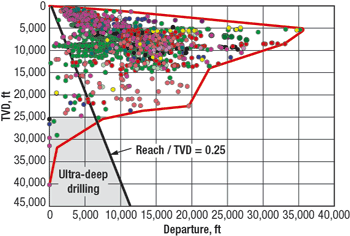 |
Fig. 3. Industry ERD Database shows drillers’ ability to extend well departures, but with reduced success in the ultra-deep regions.
|
|
Operators have identified reserves that now require overcoming UDD challenges. Projects throughout the world have been identified and are in the planning stages, including multiple projects within the Gulf of Mexico (GOM) shelf and deepwater, deepwater West Africa, Brazil, Trinidad and Malaysia, and UD gas recovery projects beneath the Caspian Sea.6
ADVANCED MATERIALS
Many industry publications have presented the idea of using non-steel drillstrings, primarily for torque and drag load reduction within ER wells. However, other torque and drag reduction/ management tools and techniques have proved successful, are lower cost and more practical. These are meeting ER torque and drag challenges and inhibiting the progress of commercially available non-steel drill pipe.6
Industry’s move toward UDD has led to increased consideration of non-steel drill pipe. Three advanced materials are included in this discussion: carbon fiber composites, titanium and aluminum. These have been studied and each has been employed in drillstrings with varying degrees of frequency and success. Each material has strengths and weaknesses as drill pipe to drill ultra-deep, extended reach and deepwater wells.
Carbon fiber composites. Composite Drill Pipe (CDP) is manufactured by winding carbon fibers over a mandrel, while applying an epoxy matrix that encases the fibers and seals the assembly. CDP has incorporated steel pin and box tool joints similar in design to conventional steel drill pipe connections. The steel tool joints are attached to the composite tube during the winding process where the carbon fibers are placed over specially designed tool joint ends to bond with the composite tube and resist fatigue damage in service. Presently, CDP is about three times the cost of conventional steel drill pipe. As the technology improves, this differential may decrease.
CDP offers several potential advantages over conventional steel drill pipe:
- Lower weight
- Higher strength-to-weight ratio
- Superior corrosion resistance
- Enhanced fatigue resistance
- Non-magnetic.
These advantages could make CDP well-suited to UDD and other drilling applications. Its major disadvantage is in hydraulic performance and efficiency, which has prevented its application in UDD and ERD. To achieve the necessary structural properties (torsional strength, tensile capacity and pressure integrity), a composite tube must be significantly thicker than conventional steel drill pipe. Depending on the design, the wall thickness of CDP may be twice the wall thickness of comparable steel drill pipe. This results in a significantly reduced ID, resulting in unacceptable pressure losses.
CDP’s high strength-to-weight ratio gives it a major advantage compared to steel for torque and drag. However, since hydraulic efficiency is just as important for UDD, composites do not offer a viable solution. CDP designers have increased the OD of the pipe to accommodate increased wall thickness. For example, 5-7/8-in. OD steel drill pipe is commonly used for UDD. CDP with a 6-in. OD has been proposed for these applications. Even with this adjustment, the reduced ID increases pressure losses, and the increased OD increases annulus Equivalent Circulating Densities (ECD). This can create well control issues especially in wells with narrow mud weight to formation fracture gradient margins.
CDP has had some success in ultra-short radius drilling, where its flexibility and fatigue resistance is advantageous. Ultra-short radius drilling is not usually constrained by hydraulic performance issues.
Titanium drill pipe. Titanium Drill Pipe (TDP) has been successfully manufactured on a very limited scale for ultra-short radius drilling applications. Small diameter TDP (2-1/2-in. and 2-7/8-in.) proved useful for ultra-short radius drilling in several field trial and commercial applications. Unfortunately, the pipe manufacturing cost was very high (seven to ten times more than steel) and the market was very limited.
TDP assemblies consisted of titanium-alloy tubes with internal/ external upsets on both ends, high-performance, fatigue-resistant, proprietary, low-alloy carbon steel tool joints and an optimized connection interface between the steel tool joint and upset tube.7 TDP offers significant performance advantages over conventional steel drill pipe for UDD:
- Lower weight
- Strength-to-weight improvement of about 37% over S-135 steel drill pipe
- High corrosion and erosion resistance
- Good fatigue resistance.
Titanium is more flexible than steel with a modulus of elasticity of 17 million psi versus 30 million psi for steel. While this property was highly advantageous in ultra-short radius drilling, it may hamper UDD operations. A TDP string will have roughly twice the deformation for the same induced stress. This causes TDP to behave differently than conventional steel drill pipe. A TDP string might have a delayed response to working torque changes, RPM and picking-up off bottom. It takes longer for changes made at the surface to work through the drillstring. This response difference can be accommodated, but there can be a significant learning curve.
There is little question that manufacturers can make a high performance UDD drillstring from titanium that provides an innovative technical solution. There are questions that must be answered before TDP will be seriously adopted for UDD, ER and other challenging projects:
- Is anyone willing to pay the high cost?
- How much better will TDP perform, compared to advanced ultra-high-strength steel with minimum specified yield strengths in the range of 165,000 psi? Compared to 165,000 ksi yield steel drill pipe, the strength-to-weight ratio advantage for TDP (at 120 ksi yield strength) drops to 15%.
Aluminum drill pipe. Aluminum Drill Pipe (ADP) has been used by the petroleum industry for decades. Most of this experience comes from Russia and the FSU, where drillers use ADP extensively. Based on this field history, ADP is a proven product. ADP was used in North and South America on a limited basis in the 1960s and 1970s to extend the depth capacity of existing rigs and to reduce weight for helicopter-transported rigs. Some have referred to ADP as the “poor man’s” TDP because it shares some of the desirable features of TDP at a significantly lower cost. ADP advantages include:
- Lower weight
- Good corrosion resistance
- Enhanced fatigue resistance
- Non-magnetic.
ADP is made from forged aluminum tubes that have upset ends. Threaded steel tool joints are bucked on to the tubes with either a shrink-fit connection or with some type of adhesive in the threaded region to secure the two members (see World Oil, July 2006).
It costs about twice that of conventional steel DP; although this is highly dependent on the specifications for each product. Some sources have indicated that this cost deferential may have decreased recently.
ADP may have application for ER and horizontal drilling, but some characteristics make it a poor candidate for UDD. It has relatively low yield strength of about 69,000 psi (highest yield strength alloy used for drill pipe). Consequently, it has a lower strength-to-weight ratio than ultra-high-strength steel drill pipe when factoring in the steel tool joints. It requires a greater wall thickness than steel drill pipe, which adversely affects hydraulic performance. In addition, its yield strength in service can drop dramatically at temperatures above 250°F. Since high temperatures are often encountered in UDD, ADP is unsuitable for many wells.
High-strength steels. High-strength steels are a near-, mid- and long-term technology for UDD. Current high-strength grades on the market today are Z-140 and V-150. These provide 4% and 11% improvement, respectively, in strength-to-weight ratio, compared to S-135 drill pipe. Cost multipliers for these grades are modest compared to S-135.
The industry has been slow to adopt them, but the recent push toward deeper wells has given the grades momentum. Over 500,000 ft of Z-140 and over 175,000 ft of V-150 are in use. These grades are used for drillstrings, but an increasing trend is to use them in dedicated drill pipe landing strings of reduced cyclical loading.
The reduced ductility/ toughness of high-strength steels inhibits their adoption. However, manufacturers have improved the technology and now offer these grades with Longitudinal Charpy V-Notch (LCVN) toughness levels better than API S-135. In addition, manufacturers are implementing chemistry, heat treatment and manufacturing improvements that may enable manufacturing these grades to more stringent toughness criteria.
In 2003, Chandler, et al., published the state-of-the-art technology in high-strength steels.8 Analyzing statistical measurements, such as cumulative density functions (CDF) on yield strength and toughness values, there was about an 18% probability that Z-140 LCVN values would fall below 59 ft-lbs (3/4 size at – 4°F). There was a 100% probability that V-150 LCVN values would fall below 59 ft-lbs. Looking at the data in 2006 (including the 2003 data), there is a 9% chance Z-140 and 50% chance V-150 will have LCVN values that fall below 59 ft-lbs. The probability of achieving high ductility/ toughness in these high-strength steels has improved 50% in the past three years, Fig. 4.
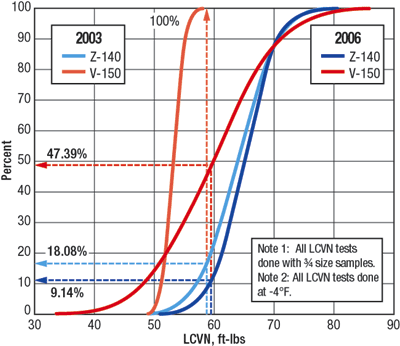 |
Fig. 4. Cumulative density function plots show about 50% toughness improvement in high-strength steels over the past three years.
|
|
The substantial improvement in obtaining high toughness within high-strength steels has led drill pipe manufacturers to develop ultra-high-strength steels such as UD-165. The development of UD-165 grade with 165 ksi yield strength tubes would provide a 22% improvement in strength-to-weight ratio compared to S-135. This would be second only to TDP by 15% in strength-to-weight ratio. It is likely that UD-165 cost would be substantially less than TDP. Table 1 compares advanced Z-140, V-150 and UD-165 steel drill pipe alongside S-135.
 |
| TABLE 1 |
|
Strength-to-weight ratio comparisons of many steel grades to non-steel alternative materials including attached steel tool joints.
Click image for enlarged view |
|
|
When considering strength-to-weight ratio, many publications have not factored in the steel tool joints attached to the non-steel alternative material tubes. Rather, they have focused only on the material density strength-to-weight ratio improvement. This is somewhat misleading and errs on the side of promoting non-steel alternatives. However, Table 1 factors in steel tool joints and uses a conservative approach by analyzing Range 3 drill pipe.
OPERATIONAL CHALLENGES
There are several operational challenges that become increasingly important when considering UD wells. Because UD wells increase axial load and tension in the drillstring, many items require increased oversight, compared to typical depth wells. Figure 5 presents a state-of-the-art drill pipe landing string design.8
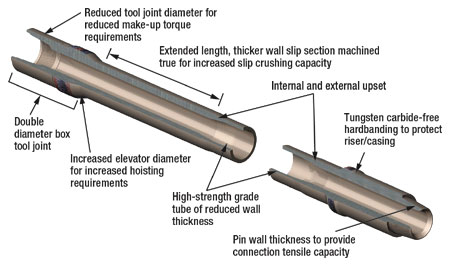 |
Fig. 5. Drill pipe landing string design for ultra-deep wells with thicker wall slip section to improve slip-crushing resistance.8
|
|
Slip-crushing. With increasing axial load, the slips exert bi-axial loads to the drill pipe that convert to hoop stress in the tube. Excessive hoop stress can lead to drill pipe collapse. Damage to slip and slip dies can also result. Drill pipe slip crushing presents a very real and immediate issue to UDD. In the deepwater GOM, slip-crushing has been documented, and some failures have resulted in catastrophic casing string loss to the sea floor.9
To improve slip crushing capacity, a machined OD and ID tube of improved eccentricity and ovality is welded between the box tool joint and drill pipe tube upset. The slip section is a larger wall thickness than the tube. For design purposes, the slip section wall thickness and material strength provides greater slip-crushing capacity than the tensile capacity of the tube to which it is attached. The slip section can be as much as 80 in. long for easy slips installation.
Slip manufacturers have also developed technologies to improve slip crushing capacity and minimize damage to slip inserts. Recently, some of the industry’s first 2 million lbf slips were introduced to the market. Three key features are load distribution grooves, extended slip contact length and the taper increase between the slips and bowl to reduce transverse loading, Fig. 6.
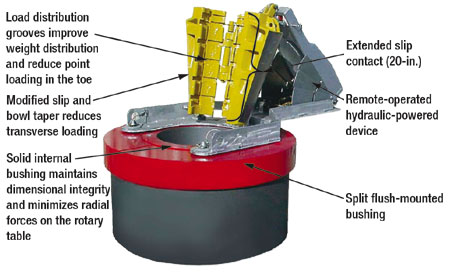 |
Fig. 6. The 2 million lbf slip system reduces transverse loading to the pipe. Courtesy of Access Oil Tools.
|
|
Hoisting capacity. Drillstring hoisting capacity is an area of increased importance when undertaking UD wells. Confirming that the top drive rating exceeds anticipated drillstring weight plus a safety factor is one aspect. Another aspect is ensuring that elevator tonnage ratings also exceed the weight of the drillstring, plus a safety factor. However, one area of increasing concern, and one not readily verified, is tool joint elevator capacity.
The increasing trend in UDD and deep directional wells is to use proprietary high-torque tool joint connections on the drill pipe. One feature of these is reduced OD for ECD management. More streamlined product configurations are being offered, where the tool joint OD more closely approximates the tube OD. For example, a popular size in UDD is 5-7/8-in., 0.75-in. wall S-135 drill pipe with 7-1/4-in. × 3-1/2-in. connections. The maximum upset diameter for this pipe is 6 in., and the typical elevator bore diameter is 6-1/8 in. This leaves about 9/16 in. of radial contact along the 18° taper of the box tool joint and the elevator bushing. Tool joint elevator capacity is very much a function of the tool joint OD. Drillstring design engineers should consult the Original Equipment Manufacturer (OEM) to obtain tool joint elevator capacity charts based on tool joint OD to ensure hoisting loads are within the capacity of the tool joint/ elevator contact area, Fig. 7.
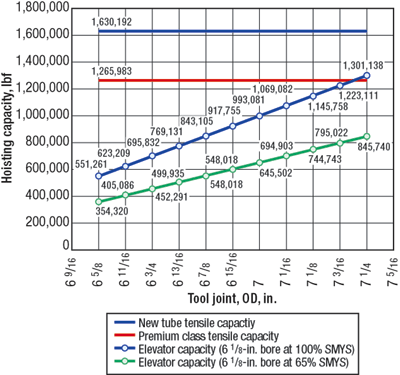 |
Fig. 7. Hoisting capacity is a function of tool joint OD.
|
|
Drill pipe manufacturers have developed tool joint designs that provide elevator capacity, while maintaining balanced connections and fishability. Double-diameter tool joints were introduced to the industry in early 2002. At one end of the tool joint near the 18° taper, one diameter is present that is larger than the standard tool joint diameter. This diameter is defined such that tool joint elevator capacity is greater than tube tensile capacity. The smaller tool joint diameter is defined to balance the area/ moment-of-inertia ratio between the pin and box to maximize fatigue performance of the tool joint. In addition, fishing consideration may be given to the smaller tool joint diameter. Most overshot fishing tools are capable of catching the smaller tool joint diameter without interfering with the larger diameter near the 18° taper.
BOP pipe shearing. The use of high-strength, high-toughness drill pipe of increased wall thickness has in some cases exceeded the capacity of some BOP shear rams to successfully and or reliably shear drill pipe. To reduce the probability of drillstring failure, the industry has increased its use of high-toughness drill pipe. In response to this, drill pipe manufacturing companies have implemented chemistry, heat treatment and manufacturing advances that produce extremely ductile pipe, even in high yield-strength products such as Z-140 and V-150 products.
In response, BOP manufacturers have taken a number of steps. They have executed numerous shear tests on pipe of varying OD, wall thickness, grade and toughness. Levett showed that shearing pressure requirements are more directly tied to toughness/ ductility than the strength of the pipe; though it is also an influencer.10 Based on this testing, BOP manufacturers have revisited prediction shearing formulas.
UD wells beyond 25,000-ft TVD often require large OD tubulars, such as 6-5/8-in. with tapered wall thicknesses ranging from 0.361-in. to as much as 0.938-in. thick. These are often manufactured to stringent and elevated toughness requirements greater than 59 ft-lb (3/4 size samples at – 4°F). They are often high-strength S-135, Z-140 and V-150 products. In some cases, as many as four different wall thicknesses of 6-5/8-in. drill pipe are used in the same string.
Each of these UDD drillstring trends – increasing wall thickness, increasing yield and ultimate tensile strength, and increasing material ductility – adversely impact the ability of the BOP to successfully and reliably shear drill pipe. It is important during UD well planning that engineers fully evaluate the BOP’s ability to shear the drill pipe.
Hang-off BOP capacity with external pressure. Another operational concern in UDD is potential loading applied to the drillstring. This scenario can occur during a well control event or during displacement operations to control a kick. Once a kick is detected, the standard procedure is to shut-in the well and take pressure measurements to estimate the kick’s intensity and size. If the well is left shut-in and the kick is allowed to migrate up to the BOPs, the pressure in the annulus will increase substantially, depending on the nature, size and intensity of the kick, as well as well geometry, fluid weights, etc.
Because floats are often run inside the drillstring, an accompanying pressure increase inside the drillstring may not occur, and a significant pressure imbalance between the drill pipe external and internal pressures may develop at or near the BOPs. Well control pressures in the annulus can form an effective collapse load on the drill pipe, which may threaten the pressure integrity of the seal between the BOPs and the drillstring.
During this scenario, the effective pressure limit of the well may be limited by the collapse rating of the drill pipe, despite the fact that a 10-ksi or 15-ksi BOP system is in place. This is important in UD wells for two reasons:
- Increased axial load to the drill pipe reduces drill pipe collapse resistance
- Larger OD drill pipe run in UD wells has lower collapse resistance than smaller OD tubulars of equal wall thickness.
Drillstring design engineers for UD wells should consider the reduced drill pipe collapse resistance at the BOP under the appropriate heavy tension loads. In addition, the use of ported drill pipe floats may aid in reducing pressure differentials across the drill pipe. Operations personnel should consider this potential loading scenario and account for it during planning for well control events on UD wells.11
BHA connections for UDD. Considering the cost of drillstring failures in UD wells, it is essential that advanced drillstring technology be utilized to minimize risk. Of particular concern is BHA connection failure. Trips at UD well depths are costly and unsuccessful openhole fishing operations followed by sidetracks are even more costly.
To enable telemetry transmission of wired drillstrings, a requirement for double-shoulder connections in the BHA has developed. In response, drillstring manufacturers have developed proprietary double-shouldered BHA connections to maximize fatigue performance and permit telemetry transmission. These enhanced connection designs were verified through finite element analysis, full-scale fatigue, torsion and make-and-break testing, plus field trials in aggressive drilling programs with elevated BHA vibration. Results indicate that the enhanced BHA connection provides at least nine times greater fatigue resistance than its API counterpart connection, 6-5/8-in, regular, of equivalent OD and ID, Fig. 8. In addition, noticeable improvement in running time and material loss upon recut have been observed.12
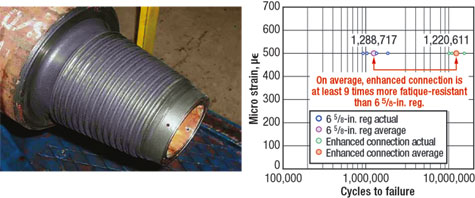 |
Fig. 8. Full-scale fatigue testing (right) indicates that enhanced BHA connection (left) provides at least nine times more fatigue resistance than API 6-5/8-in. reg. connection.12
|
|
CONCLUSIONS
The trend toward UD wells is increasing with wells deeper than a 25,000-ft TVD and with departure/ TVD ratios less than 0.25 becoming more common. Since 1995, the number of annual US wells deeper than a 15,000-ft TVD has more than doubled. These UD wells present strong challenges to drillstring design engineers that may prove more demanding than those overcome in ER programs.
Long-term solutions for overcoming the tension barrier in UD wells may include non-steel alternative drill pipe products. These products will require investment in design verification, full-scale physical testing and field trials to understand the risks and different mechanics. Near- and mid-term solutions should focus on the use and development of ultra-high-strength, high-toughness steel drill pipe. These provide adequate strength-to-weight ratios at a fraction of the cost of non-steel alternative materials.
Increased axial loads associated with UD wells require improved design assessment in slip-crushing and hoisting capacity. New drill pipe and handling equipment technologies provide novel solutions for current UDD requirements.
UD drilling presents increased operational considerations that require attention of the well designer. BOP shearing capacity of drill pipe and BOP pressure integrity upon drill pipe collapse are adversely affected in UD wells. Well designers should work closely with OEMs to fully evaluate the performance limits of these products in UD applications.
The risk and cost of UD wells will strongly benefit from advanced BHA connection technology aimed at mitigating downhole failures. Enhanced BHA connections are available with fatigue performance of a full order of magnitude improvement over current API connections. 
ACKNOWLEDGEMENT
This article was presented as a paper at the 2006 IADC World Drilling Conference in Prague, Czech Republic, June 21-22, 2006.
LITERATURE CITED
1 Spears & Associates, Inc., Drilling & Production Outlook, June 2006.
2 Mayerhofer, and M. J., S. L. Wolhart, J. D Rogers, “Results of US Department of Energy deep gas well stimulation study,” SPE 95639, presented at the 2005 SPE Annual Technical Conference and Exhibition, Dallas, Texas, US, October, 9 – 12 2005.
3 Schlumberger Data and Consulting Services, “Benchmarking deep drilling final report,” prepared under contract no. DE-AM26-99FT40465 Concurrent Technologies Corp. Task FT50201H, April 2005.
4 “Discoverer Spirit sets deep drilling records,” Rigzone News, December 29, 2005.
5 “Transocean Inc. awarded five-year contract for construction of enhanced enterprise-class drillship and two multi-year contract extensions,” Webbolt Newsroom, March 02, 2006.
6 Smith, J. E., and R. B. Chandler, P. L. Boster, “Titanium drill pipe for ultra-deep and deep directional drilling,” presented at the 2001 SPE/ IADC Drilling Conference, Amsterdam, The Netherlands, February 27 – March 1, 2001.
7 Smith, J., and M. J. Jellison, G. Wilson, J. Hunter, P. Boster and J. Rubli, “Titanium pipe proving ideal for short radius drilling,” American Oil & Gas Reporter, September 2000.
8 Chandler, R. B., and M. J. Jellison, M. L. Payne, J. S. Shepard, “Performance driven drilling tubular technologies,” SPE/ IADC 79872, presented at the 2003 SPE/ IADC Drilling Conference, Amsterdam, The Netherlands, February 19 – 21, 2003.
9 Woltman, G., and R. Fowler, F. Mosely, D. Nedorostek, “Investigation of equipment failure Green Canyon block 242, Well No. 1 OCS-G 21788 September 5, 2004,” OCS Report MMS 2005-027.
10 Levett, B., “The effects of improved drill pipe properties on BOP shearing capabilities,” presented at the 2003 IADC World Drilling Conference, Vienna, Austria, June 25 – 26, 2003.
11 ISO/ CD 10407-1 Petroleum and natural gas industries – Drilling and production equipment – Part 1: Drill stem design and operating limits,” April 21, 2004.
12 Chandler, R. B., and A. Muradov, M. L. Payne, J. C. Wright, M. J. Jellison, M. E., Reeves, D.S. Pixton, “Beyond stress relief features…The bottom hole assembly connection for the harshest fatigue environments,” presented at the 2005 SPE/ IADC Middle East Drilling Technology Conference & Exhibition, Dubai, U.A.E., September 12 – 14, 2005.
|
THE AUTHORS
|
 |
R. Brett Chandler earned a BS degree in mechanical engineering from The University of Texas at Austin in 1993. Chandler has authored numerous papers and instructed courses on tubular design and integrity. He is chairman to the ISO TC67/ SC4/ WG1 workgroup on drilling equipment standards, project leader for ISO 10407-1 (API RP7G equivalent) and serves as co-chairman to API SC5/ TG3 drillstem elements committee. Chandler is manager of Marketing and Product Management for Grant Prideco’s Drilling Products and Services Division. He directs new product development, manages drillstem business efforts and provides technical representation of Grant Prideco’s products to its customers.
|
|
 |
Michael J. Jellison earned a BS degree with honors in mechanical engineering from Texas A&M University in 1980. Jellison has published numerous technical papers for SPE, IADC, ASME and several trade journals. He has conducted seminars on casing and tubing design, premium connectors, drillstem products and cementing, and is a registered professional engineer. Jellison is vice president of Engineering for Grant Prideco’s Drilling Products and Services Division where he directs efforts in Product Engineering, R&D and metallurgical technology. He initiated the Grant Prideco effort to develop and manufacture 5-7/8-in. drill pipe for extended reach, deepwater and ultra-deep drilling applications.
|
|
 |
Mike L. Payne earned BS and PhD degrees in mechanical engineering from Rice University, an MS degree in petroleum engineering from the University of Houston, and executive education from the University of Chicago GSB. Payne has 26 years of drilling experience, including operations, computing, technology and consulting. He has extensive industry publications, is chairman of the API Pipe Committee (SC5), chairman of ISO TC67/ SC4 and convenor of ISO SC5 WG2. He serves on the board of the Drilling Engineering Association, has been recognized by SPE as a distinguished lecturer and was the SPE International Drilling Engineering Award recipient for 2000. Dr. Payne is a senior advisor for BP in the Exploration and Production Technology Group.
|
|
 |
Jeff S. Shepard earned a BS degree from the US Merchant Marine Academy at Kings Point, New York. He has served in various positions in drilling operations management, new construction, rig conversion project management, engineering, preventive maintenance program management, and, most recently, establishing fleet-wide engineering and maintenance standards for GlobalSantaFe Corp. He is active in API standards development, both as a chairman and participant in several work groups for establishing new and revised industry standards for drilling equipment and tubular goods, and is a past chairman of the IADC Maintenance Committee. Shepard has been working in the offshore drilling industry for 34 years and is manager of Operations Support for GlobalSantaFe.
|
|
|















